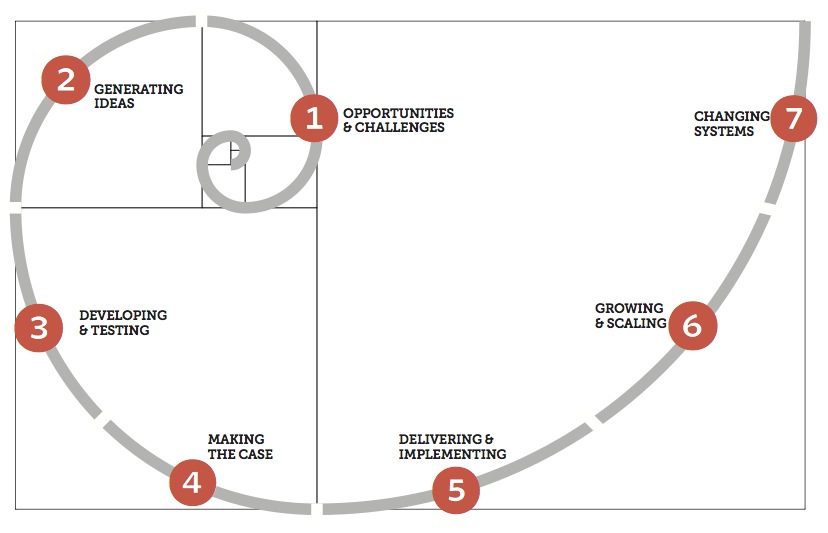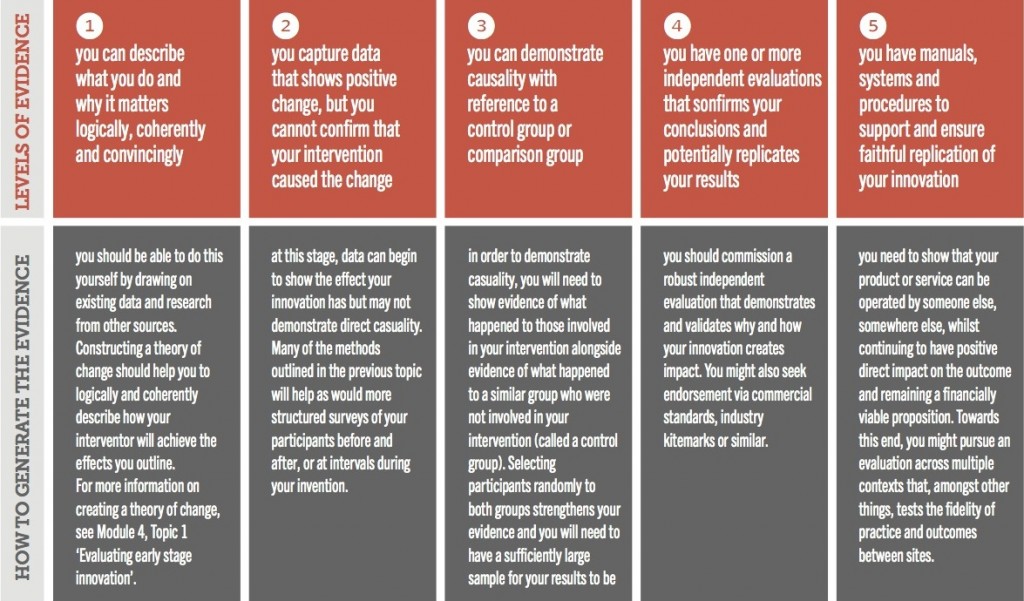The Development Impact and You toolkit has been specially designed for practitioners to dive straight into action. Yet the tools presented here are grounded in existing theories and practices of innovation, design, and business development.
This section offers a ‘bird’s eye view’ of the main pillars underlying the theory and management of social innovation and for each of these topics we have provided references for further reading.
1. Stages of Innovation
Innovation is sometimes written about as an almost magical process. But it is wrong to see innovation as a mystery. It is true that innovation is rarely simple or predictable, but looking closely at what actually happens, it is also true that the overall innovation process is structured and systematic.
Although every real innovation is a complex story of loops and jumps, there are various stages that most innovations pass through. This framework is useful for understanding how to put ideas to work, and focusing on the different methods, and different mindset, needed at each stage.
The seven stages are:
Opportunities & challenges: These include all the initiating factors like a crisis, new evidence, inspirations etc. which highlight the need for change. This might involve diagnosing the root causes of a problem, or identifying the opportunities that a new change could bring about.
Generating ideas: Most of the ideas you come up with at first won’t work. But it’s only through the process of constant idea creation that you arrive at something that is radical and transformative. Use creative methods like design to increase the number of solution options from a wide range of sources.
Developing & testing: New ideas are always helped by robust criticism. It is through trial and error that ideas are iterated and strengthened. This can be done by simply trying things out, or through more rigorous prototyping and randomised controlled trials.
Making the case: Before you try to implement your idea, you need to prove that it can work and is better than what is already there. Build up firm evidence to back it up and then share it honestly.
Delivering & implementing: This is when the solution becomes everyday practice. It includes identifying what is working well, and what is not, as well as securing income streams that enable the long term financial sustainability to carry the innovation forward.
Growing & scaling: In this stage there are a range of strategies for growing and spreading an innovation – from organisational growth, to licensing and franchising. Emulation and inspiration also play a critical role in spreading an idea or practice in a more organic and adaptive manner.
Changing systems: Systemic innovation is where maximum social impact can be created. It usually involves changes in the public and private sector over long periods of time, and the interaction of many elements and new ways of thinking.
Further reading on the stages of innovation:
- Caulier-Grice J., Mulgan G., Murray R., (2010) Open Book of Social Innovation. London, The Young Foundation, Nesta & The Lab.
- Nesta (2013) Introduction to Innovation.
2. Use of Evidence
Have a plan for building evidence from the outset of your project. All innovators, commissioners, service users and investors need evidence to know whether the products or services they develop, buy or invest in make a positive difference. In fields such as medicine, using evidence is much more common and offers interesting opportunities to learn from. The main benefit of regular and systematic reviewing of evidence is that is enables a more effective way to use data or information to test assumptions, continually improve, and create a more sustained impact. Using evidence as a natural part of projects and decision making should be common practice for organisations. And not just evidence on your current projects : understanding what has worked before, and awareness of what works in the wider landscape makes it easier to evaluate and replicate success. Below is a useful framework that Nesta has developed to show the different standards of evidence that you should aim to build up throughout a project to show that it is making a difference :
Level 1 : Account of impact: A clear explanation of what the new or improved product or service does and how it could have impact on your intended outcome, and why that would be an improvement on the current situation.
Level 2 : Correlation: Observation of some positive impact happening on the part of the users of the product or service, but no confirmation yet on what caused this. You might conduct pre and post survey evaluations, or a cohort/panel study for instance.
Level 3 : Causation: Establishment of evidence of positive change amongst the users of the product or service due to the product or service. Think about how to isolate the impact of the product or service through a control group selected randomly to strengthen your evidence base.
Level 4 : Independent replication: Independent validation of the positive outcomes of the product or service, with the aim to deliver this positive impact at a reasonable cost in other places, such as commercial standards or industry kitemarks.
Level 5 : Scaled: Use methods like multiple replication evaluations or future scenario analysis to generate clear and tested evidence that the product or service can been delivered at multiple locations and delivers a strong, positive impact, whilst remaining a financially viable proposition.
Further reading on the stages of innovation:
- Puttick R. (2011) Ten Steps to Transform the Use of Evidence. London, Nesta.
- Ludlow J., Puttick R. (2012) Standards of Evidence. London, Nesta.
- Mulgan G., Puttick R. (2013) Making Evidence Useful: The Case for New Institutions. London, Nesta.
- DFID : Department for International Development (2013) How to note. London, DFID.
- BOND for International Development (2013) Evidence Principles. London, BOND.
3. Scaling Up
The concept of scaling up is attracting increasing attention as it extends the reach of innovative pilot projects to large populations. There are many ways of scaling up – from repeating an idea in a different place, or collaborating with different organisations and building relationships that work.
To determine if a project is ready to scale and achieve greater impact in a more widespread manner, it is important to find the things that work, get them to work smoothly and move them up to the next level. It is useful to think through effective demand and effective supply; i.e. is there someone out there who is willing to pay for your idea? And does your idea work, and does it work better than the alternatives? Nearly always the task of scaling a social idea involves increasing both effective supply and effective demand, but your strategy will vary greatly depending on which comes first.
From a distance great innovations may look like radical leaps. But from close up they often turn out to be made of small steps that build on each other to achieve bigger scale. Under a microscope the different stages of innovation might be magnified to show ‘mini-spiral’ processes taking place – individual projects that an organisation might be developing to support the overall innovation process.
Further reading on the stages of innovation:
- Ali R., Mulgan G., Halkett R., Sanders B. (2007) In and out of sync: The challenge of growing social innovations. London, Nesta.
- Cooley L., Kohl R. (2006) Scaling Up – From Vision to Large-scale Change: A Management Framework for Practitioners. Washington, Management Systems Institute, John D. and Catherine T. MacArthur Foundation.
4. Systems Thinking
The word ‘system’ refers to complex and interdependent infrastructures, rules and patterns in our societies and economies. Changes in one part may affect other parts, so complex issues require changes and innovations across the system.
Systems thinking brings together the different elements and innovations that achieve a common purpose. A single organisation almost never has all the skills and resources to provide the full range of activities that are needed to create a big impact. This means that an innovation resulting in systemic change almost always involves an alliance of partners, suppliers and distributors, supported by networks, clubs, think tanks and development agencies.
Further reading on the stages of innovation:
- Leadbeater C., Mulgan G. (2013) Systems Innovation Discussion Paper. London, Nesta.
- Seddon J. (2013) Systems failure and Systems thinking. London, Nesta.


